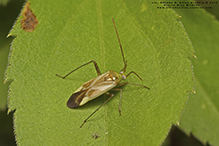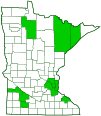alfalfa plant bug
(Adelphocoris lineolatus)
Conservation • Description • Habitat • Ecology • Distribution • Taxonomy
|
|
||||||||||||||
Description |
Alfalfa plant bug is an exotic, colorful, plant-feeding, true bug. It is native to Europe, western Asia, and northern Africa. It was introduced into North America in Nova Scotia in 1917. It now occurs from coast to coast in southern Canada and the northern half of the United States. It is found in agricultural fields and in grassy areas. Both adults and nymphs feed on the growing parts of many plants, causing stunted plant growth and deformation. The main hosts in North America are alfalfa and red clover. Alfalfa plant bug is considered a serious pest to many agricultural crops worldwide, especially alfalfa. In two years an infestation can destroy 50% of an alfalfa crop. The adult body is soft, long, slender, and more or less parallel along the sides. Males are 5⁄16″ to ⅜″ (8.3 to 9.5 mm) in length, females are a little smaller, ¼″ to 5⁄16″ (7.6 to 8.3 mm) in length. The head is green. It is shorter than the first segment of the thorax (prothorax) and much shorter than the antennae. There are two large, black, compound eyes and no simple eyes (ocelli). The mouth parts take the form of a long, 4-segmented beak that projects downward and is optimized for piercing and sucking. The antennae are long, slender, thread-like, and about as long as the body. The upper thoracic shield (pronotum) is light green behind the head grading to brownish at the base. There are two round black spots in the middle of the pronotum directly behind and slightly smaller than the compound eyes. There are two pairs of wings. They are held flat over the body when at rest. They are longer than and completely cover the body. The front wings (hemelytra) are longer than the hind wings. The exoskeletal plate between the wing bases (scutellum), is large, triangular, and yellow, with a pair of closely-spaced, longitudinal, black stripes in the middle. The hemelytra have a thickened, leathery part at the base and a thin membranous part at the tip with a clear dividing line between the two. The thickened part is comprised of the narrow area (clavus) behind the scutellum when the wings are closed and the broad marginal area (corium). At the end of the corium there is a small but distinct triangular area (cuneus). The clavus and corium are light green or pale brown, with brown markings. The cuneus is always light green or pale brown with no black markings. The membranous tip is dark brown to blackish-brown with yellow veins. It has two closed cells. The hind wing is completely thin and membranous. The legs are long, delicate, pale, and peppered with brown specks. The last part of the leg (tarsus), corresponding to the foot, has 3 segments. Nymphs look like adults but lack wings. |
Size |
Male: 5⁄16″ to ⅜″ (8.3 to 9.5 mm) Female: ¼″ to 5⁄16″ (7.6 to 8.3 mm) |
Similar Species |
Habitat |
Fields, grasslands, agricultural crops |
Ecology |
Season |
Two or more generations per year: Early June through late September |
Behavior |
|
Life Cycle |
|
Nymph Food |
Growing parts on many plants, especially alfalfa and red clover |
Adult Food |
Growing parts on many plants, especially alfalfa and red clover |
Distribution |
||
|
Sources |
|
| 11/17/2024 | ||
Occurrence |
||
Common |
||
Taxonomy |
|
Order |
Hemiptera (True bugs, Hoppers, Aphids, and Allies) |
Suborder |
Heteroptera (True Bugs) |
Infraorder |
Cimicomorpha |
Superfamily |
Miroidea |
Family |
|
Subfamily |
Mirinae |
Tribe |
Mirini |
Genus |
Adelphocoris |
Subordinate Taxa |
|
|
|
Synonyms |
|
|
|
Common Names |
|
alfalfa plant bug lucerne bug (Europe) |
|
Glossary
Corium
The thickened basal portion of the front wing that lies between the clavus and the membrane of insects in the family Hemiptera. Plural: coria.
Cuneus
The triangular, hardened, horn-like tip of the forewing of a plant bug (family Miridae).
Hemelytron
The forewing of true bugs (order Hemiptera), thickened at the base and membranous at the tip. Plural: hemelytra.
Ocellus
Simple eye; an eye with a single lens. Plural: ocelli.
Pronotum
The exoskeletal plate on the upper side of the first segment of the thorax of an insect.
Scutellum
The exoskeletal plate covering the rearward (posterior) part of the middle segment of the thorax in some insects. In Coleoptera, Hemiptera, and Homoptera, the dorsal, often triangular plate behind the pronotum and between the bases of the front wings. In Diptera, the exoskeletal plate between the abdomen and the thorax.
Tarsus
The last two to five subdivisions of an insect’s leg, attached to the tibia; the foot. Plural: tarsi.
Visitor Photos |
||
Share your photo of this insect. |
||
This button not working for you? |
||
Alfredo Colon |
||
 |
 |
|
MinnesotaSeasons.com Photos |
||
|
||
|

Slideshows |
|

Visitor Videos |
||
Share your video of this insect. |
||
This button not working for you? |
||
|
Other Videos |
||
Alfalfa Plant Bug (Miridae: Adelphocoris lineolatus) on Wall |
About
Jul 3, 2011 Note that this out-of-focus specimen seems to be missing its left hind leg! ;-( Photographed at Nisswa, Minnesota (01 July 2011). Thank you to WonGun Kim (@Bugguide.net) for confirming the identity of this species! |
Gemeine Zierwanze (Adelphocoris lineolatus) Close up movies |
About
Nov 22, 2012 Gemeine Zierwanze (Adelphocoris lineolatus) |
Adelphocoris lineolatus |
About
Oct 27, 2013 It is about 7-9 millimetres long and 3 millimetres wide. These plant bugs are found in fields and other grassy areas. E' lungo circa 7-9 millimetri e largo 3. Questi insetti delle piante si trovano in campi e altre aree erbose. |

Created: 12/2/2020 Last Updated: © MinnesotaSeasons.com. All rights reserved. |



